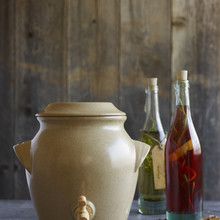
Vinegar
Ingredients:
2 parts wine (red or white)
1 part water
1 part un-pasteurised vinegar
Preparation time: 3 months
Method:
Combine all of the ingredients in a vinegar crock with a spigot on the bottom or a large, clean half-gallon glass jar or canning jar with a wide top. Loosely cover the top of the vessel with a thin kitchen towel, a triple layer of cheese cloth, or a paper towel and secure it with either a rubber band or a canning band. The idea here is to allow airflow in, but keep insects and debris out.
Store the vessel at room temperature in a dark place and let it sit, undisturbed, for 1 to 3 months. The liquid will grow more cloudy, a sheen will gather at the top, and eventually, a “mother”—a spongy, mushroom like object or very cloudy oil-like slick —will form on the surface. The best indicator of doneness is to taste your vinegar. Use your finger over a drinking straw to take a small sample of the vinegar taken from the side. If you like the flavour, proceed. If you’d like it to taste less like wine and convert further, let it sit and taste again in two weeks.
Once your wine has converted fully, you have several options. Strain the vinegar, reserving the mother. The vinegar is ready to use immediately.
The mother can be used instead of liquid starter to grow additional batches of vinegar (using the same recipe as above). Note that your mother must be “fed” with at least another cup or more of water and wine. If you don’t wish to make more vinegar, it can be refrigerated in the water and wine for later use. Old, fully spent mothers will become rubbery and solid (they are the top-most layer). These should be peeled away and discarded over time. The younger, thin layers of spore beneath it are fertile and each one is capable of beginning a new batch of vinegar. Feel free to experiment with different varietals of wine, or even sherry, hard cider, or beer, and to share your mothers with friends.
Your vinegar can be strained through a double layer of clean, thin cotton towel if you wish to have a clear product, but note that the sediment is harmless and tasteless. Homemade vinegar can also be pasteurised to prevent it from getting cloudy and producing an additional mother over time; bring it to 75 degrees C for 10 minutes, allow it to cool, then bottle.
Contributor: Cam
